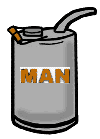|
Past Preventive Maintenance columns: Completing
Lathe Maintenance—Tailstock, Sub-Spindle, and
Zero-Point Alignment A
Closer Look at Spindles and Turrets The
Next Level: Accuracy—Checking Backlash on Lathes
Inspecting
the Electrical Cabinet Everyone's
Favorite Task—Cleaning Coolant—The
Most Ignored Fluid in your Machines It's
Summertime—Is your Chiller Working? The
Other Oils—Inspecting the Main Hydraulic Systems
|
MIKE BREEN ON PREVENTIVE MAINTENANCE |
|
Zero Points on by Michael W. Breen |
|
|
The Difference We all know machining centers are different from lathes in many ways. First, and most obvious with most MCs: the part does not rotate; the tool does. Second, instead of a chuck to hold the work piece MCs use some type of fixture or pallet tombstone. Third, MCs can have pallet changers and, instead of turrets (lathes), they have tool magazines. Lathes and MCs can both be horizontal or vertical, but most lathes are horizontal. The point is, machining centers and lathes are not the same machines, and thus their preventative maintenance needs have to be handled differently. Zero Points Depending on your control maker and machine manufacturer, changing the zero point on a machining center could affect virtually every setting from the tool or pallet change positions to the depth of cut and even the fixture offset. If you remember, changing the zero point on the X-axis of a lathe normally affects your center point to the rotating chuck. Most of the time, if a mistake is made, you would lose tool life, snap a tool or possibly cause a crash. Making a change in your X-axis on an MC could cause these things and much more. Depending on your style of machine, it could cause a misposition during a pallet change or even affect your automatic tool changer (ATC). Before you make any changes to the axis zero point on your machining center, make sure you read the machine manual and fully understand what you are doing. This is not a good time to guess and run, because you will end up having to face the music. If you have mispositioning in your pallet changer, and it becomes stuck during a change, there is a more significant problem. Pallets are normally heavy and if the change in positioning is dramatic, the pallet may end up lying by the chip auger. As we know, this is not a good thing. The recovery or repair could be even worse. The person who made the change is probably in deep hiding at this point and wishes there was such a thing as a time machine. I am not trying to scare you, but the point is to be careful and write down any changes and what the original figure is. Your X and Y zero points will affect your pallet change position, and your X, Y, and Z could affect your toolchanger. All axes will affect your tool positioning to your fixture. Be sure to test all functions of the axis after a change has been made. Performing the PM There are too many styles of machines and types of controls to give a general description on how to change the zero point. You have to refer to your machine manual. If you do not understand the written procedure, do not hesitate to contact your tool representative for a better explanation. It is a very common call, so do not feel you are belittling yourself by calling. It is better to be sure than to have to knock on the door of the plant manager and beg forgiveness for the mess for which you now are responsible. By now, you are probably thinking you would have to be crazy to even attempt a change. This is not so if you research the process and call for assistance if you have any questions whatsoever. Not performing this PM could cause as many problems as performing it incorrectly. If zero points are off and nothing is done, the ATC and MC parts will wear prematurely. You may scar the spindle taper if the tool is not centered. Tool life will be affected, and the face of your fixture could end up looking like a target on a rifle range. Next time, we will discuss the accuracies on machining centers. Talk to you next month. Mike Breen started his career as an aircraft electrician in the U.S. Army’s 101st Airborne. As a Certified Electronic Engineer with 14 years experience in machine tool repair, he is presently a Field Service Engineer with Ellison Machinery Company of Wisconsin. Mike has held this position for more than six years, during which he has designed and implemented complete preventive maintenance programs for many successful companies resulting in significant increases in their machines’ performance. For comments and inquiries about these articles, his e-mail address is mbreen@ellisonwi.com. - February 2001 |

 Last month we addressed zero points and accuracies of the lathe. Now, we’ll focus on the same subject, but with a different machine type — machining centers (MCs).
Last month we addressed zero points and accuracies of the lathe. Now, we’ll focus on the same subject, but with a different machine type — machining centers (MCs).